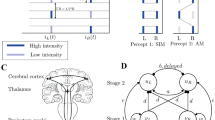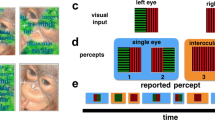Abstract
An algorithm which can be realized by synergetic systems and which was introduced by one of us (Haken 1987) for the recognition of patterns is extended so that the perception of ambiguous patterns can be modelled. In this approach so-called attention parameters are subjected to a damping mechanism mimicking the effect of saturation of attention. In this way oscillations of perception arise quite naturally. Our approach takes also ambiguous patterns with bias into account which leads to different periods of the attention paid to the one or the other interpretation of the pattern. Our results are in good agreement with previous psycho-physical studies by other authors. Finally we show how hysteresis of perception can be modelled.
Similar content being viewed by others
References
Anderson JA, Silverstein JW, Ritz SA, Jones RS (1977) Distinctive features, categorical perception, and probability learning: some applications of a neural model. Psychol Rev 84:413–451
Attneave F (1971) Multistability in perception. Sci Am 225:62–71
Borsellino A, De Marco A, Allazetta A, Rinesi S, Bartolini B (1972) Reversal time distribution in the perception of visual ambiguous stimuli. Kybernetik 10:3, 139–144
Botwinick J (1961) Husband and father-in-law: a reversible figure. Am J Psychol 74:312–313
Bugelski BR, Alampay DA (1961) The role of the frequency in developing perceptual sets. Can J Psychol 15:205–211
Eichler W (1930) Der rhythmische Wechsel in der Auffassung räumlich-zweideutiger geometrischer Figuren. Z Sinnesphysiol 61:154–193
Fisher GH (1967) Measuring ambiguity. Am J Psychol 80:541–547
Fuchs A, Haken H (1988a) Pattern recognition and associative memory as dynamical processes in a synergetic system. I. Translational invariance, selective attention, and decomposition of scenes. Biol Cybern 60:17–22
Fuchs A, Haken H (1988b) Pattern recognition and associative memory as dynamical processes in a synergetic system. II. Decomposition of complex scenes, simultaneous invariance with respect to translation, rotation, and scaling. Biol Cybern 60:107–109
Gombrich EH (1973) Illusion in nature and art. In: Gregory RL, Gombrich EH (eds) Illusion in nature and art. Duckworth, London
Gräser H (1977) Spontane Reversionsprozesse in der Figuralwahrnehmung. Dissertation, Trier
Haken H (1987) Synergetic computers for pattern recognition and associative memory. In: Haken H (eds) Computational systems, natural and artificial. Springer, Berlin Heidelberg New York
Haken H (1988) Nonequilibrium phase transitions in pattern recognition and associative memory. Z Phys B — Condensed Matter 70:121–123
Hill WE (1915) My wife and my mother in law. Puck 6. November
Jastrow J (1900) Fact and fable in psychology. Houghton Mifflin, New York
Kawamoto AH, Anderson JA (1985) A neural network model of multistable perception. Acta Psychol 59:35–65
Köhler W (1940) Dynamics in psychology. Liveright, New York
Kruse P (1988) Stabilität, Instabilität, Multistabilität, Selbstorganisation und Selbstreferentialität in kognitiven Systemen. Delfin 11:35–58
Leeper RW (1935) A study of a neglected portion of the field of learning-the development of sensory organization. J Genet Psychol 46:41–75
Lorscheid T, Hofmeister K (1980) An early ambiguous sculpture. Perception 9:113–114
Marbe K (1893) Die Schwankungen der Gesichtsempfindungen. Phil Stud 8:615–637
Necker LA (1832) Observations on some remarcable phenomenon which occurs on viewing a figure of a crystal or geometrical solid. London Edinburgh Philos Mag J Sci 3:329–337
Orbach J, Ehrlich D, Heath HA (1963) Reversibility of the Necker cube. I. An examination of the concept of “satiation of orientation”. Percept Mot Skills 17:439–458
Pöppel E (1982) Lust und Schmerz. Neuronale Grundlagen menschlichen Verhaltens. Severin & Siedler, Berlin
Porterfield W (1759) A treatise on the eye, the manner and phenomena of vision. Hamilton and Balfour, Edinburgh
Rubin E (1921) Visuell wahrgenommene Figuren. Gyldendalske, Copenhagen
Stadler M, Erke H (1968) Über einige periodische Vorgänge in der Figuralwahrnehmung. Vision Res 8:1081–1092
Wallach H, Austin P (1954) Recognition and localization of visual traces. Am J Psychol 67:338–340
Author information
Authors and Affiliations
Rights and permissions
About this article
Cite this article
Ditzinger, T., Haken, H. Oscillations in the perception of ambiguous patterns a model based on synergetics. Biol. Cybern. 61, 279–287 (1989). https://doi.org/10.1007/BF00203175
Received:
Accepted:
Issue Date:
DOI: https://doi.org/10.1007/BF00203175




